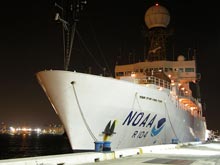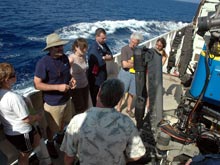The NOAA research vessel (R/V) Ronald H. Brown at Pier 22 in Port Everglades. The lights of Ft. Lauderdale, Florida, are visible in the background. All science operations during Expedition to the Deep Slope 2007 will be staged from the R/V Ronald H. Brown. Click image for larger view and image credit.
At the beginning of every cruise, Jason Expedition Leader Matt Heintz briefs the science party on proper safety procedures when working around the ROV. Click image for larger view and image credit.
Planning, Planning, Planning!!!
June 5, 2007
Jeremy Potter
NOAA Office of Ocean Exploration
24° 27.70 N
81° 21.05 W
Do a quick search on the Internet or pick up a recent copy of National Geographic magazine and you probably won’t have any trouble finding breathtaking images of underwater creatures or captivating stories about scientists exploring our world’s ocean. Although media often provide wonderful accounts of important ocean discoveries, the significance of pre-cruise preparation and planning often remains undocumented and under appreciated. Months — and sometimes years — of planning and coordination is a prerequisite for almost any safe, organized, and productive expedition.
Mission planning for this year’s expedition was already happening during last summer’s cruise on the research vessel Atlantis. Co-chief Scientists Chuck Fisher and Harry Roberts made numerous decisions before, during, and after last year’s Alvin submersible dives, which had important implications for the science plan this year. Many of their decisions, such as how much time to spend at a particular seep community or how many mussel samples to take, were based on carefully weighing the relative strengths of the Alvin human-occupied vehicle (HOV), which they used last year, and the Jason remotely operated vehicle (ROV), which they knew they would be using this summer.
After a much deserved break following last year’s cruise, organizers began periodic conference calls in early November in preparation for this year’s cruise on the NOAA ship Ronald H. Brown (RHB). The participants on these calls included Capt. Gary Petrae (RHB commanding officer), Lt. Liz Crapo (RHB field operations officer), Chuck Fisher (chief scientist), Matt Heintz (Jason expedition leader), and Cathy Offinger (Jason operations coordinator). The discussions were essential to working through many of the larger issues. This was essential to being able to sort through the finer details during two face-to-face marathon meetings in January and May.
Now all of the planning and preparation is about to pay off. Most of the Jason group and all of their gear arrived early in the morning on May 31 in Ft. Lauderdale, Florida. Soon after arrival, Matt Heintz and Chief Bosun Bruce Cowden coordinated the lifting and placement of 8- to 20-foot shipping containers onto the RHB using a large crane located on the pier. The single biggest lift was well over 9 tons.
From start to finish, fully mobilizing the ROV takes four full days. As soon as the ROV gear was loaded, the Jason group quickly started setting up equipment, running wires, and conducting tests.
Beyond the ROV gear, the science party and crew carried aboard hundreds of boxes and crates prior to departure. These gear and provisions, including everything from liquid nitrogen, computers, and test tubes to paper towels and milk, needed to be properly stowed away or secured with bungee cords, rope, and Velcro strips to prevent damage in the event of strong seas.

































